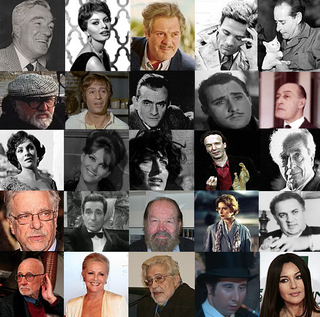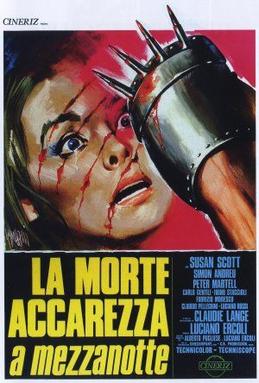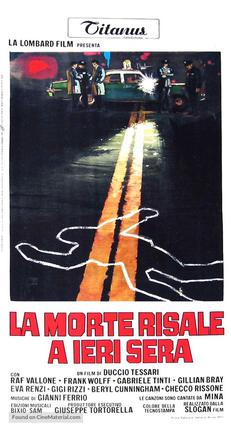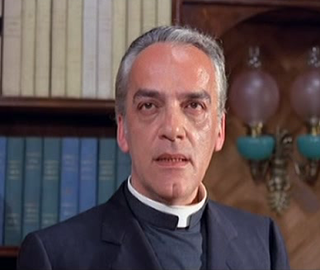
The cinema of Italy comprises the films made within Italy or by Italian directors. Since its beginning, Italian cinema has influenced film movements worldwide. Italy is one of the birthplaces of art cinema and the stylistic aspect of film has been one of the most important factors in the history of Italian film. As of 2018, Italian films have won 14 Academy Awards for Best Foreign Language Film as well as 12 Palmes d'Or, one Academy Award for Best Picture and many Golden Lions and Golden Bears.

Luigia "Gina" LollobrigidaOMRI was an Italian actress, model, and photojournalist. She was one of the highest-profile European actresses of the 1950s and 1960s, a period in which she was an international sex symbol. Dubbed "the most beautiful woman in the world", at the time of her death she was among the last surviving high-profile international actors from the Golden Age of Hollywood cinema.

In Italian cinema, giallo is a genre of murder mystery fiction that often contains slasher, thriller, psychological horror, psychological thriller, sexploitation, and, less frequently, supernatural horror elements.

Lamberto Bava is an Italian film director. Born in Rome, Bava began working as an assistant director for his director father Mario Bava. Lamberto co-directed the 1979 television film La Venere d'Ille with his father and in 1980 directed his first solo feature film Macabre.

Ewa Birgitta Aulin is a Swedish former actress who appeared in a number of Italian and some American films in the 1960s and 1970s. She is remembered for playing the title character in the cult film Candy where she appeared with John Huston, Ringo Starr, Walter Matthau, James Coburn, Richard Burton and Marlon Brando. She is known to horror film fans for starring in Death Smiles on a Murderer, Death Laid an Egg, and Ceremonia Sangrienta.

Sealed Lips is a 1942 Italian mystery thriller film directed by Mario Mattoli and starring Fosco Giachetti, Annette Bach, Andrea Checchi and Vera Carmi. It was shot at Cinecittà Studios in Rome. The film's sets were designed by the art directors Piero Filippone and Mario Rappini.

Ha fatto tredici is a 1951 Italian comedy film directed by Carlo Manzoni.

The Unfaithfuls is a 1953 Italian comedy drama film directed by Mario Monicelli and Steno and starring Gina Lollobrigida.

Giulio Questi was an Italian film director and screenwriter.

Marisa Anna Solinas, best known as Marisa Solinas, was an Italian actress and singer.
Luciano Ercoli was an Italian film director, screenwriter, producer and unit production manager. Ercoli's career spanned approximately two decades before his retirement in the late 1970s, and saw him direct several films in the giallo genre, as well producing several Spaghetti Westerns. Ercoli was married to Spanish actress Nieves Navarro, who has appeared in several of the films he worked on.

Sette scialli di seta gialla/ Seven Shawls of Yellow Silk is a 1972 Italian giallo film. It was directed by Sergio Pastore and written by Pastore, Alessandro Continenza, and Giovanni Simonelli. Sette scialli di seta gialla stars Anthony Steffen, Sylva Koscina, Jeannette Len, Renato De Carmine, Giacomo Rossi-Stuart, and Umberto Raho.

The Bloodstained Butterfly is a 1971 giallo film directed by Duccio Tessari. It starred Helmut Berger and Ida Galli.

La morte accarezza a mezzanotte is a 1972 giallo film directed by Luciano Ercoli and written by Ernesto Gastaldi, Guido Leoni, Mahnahén Velasco and Mannuel Velasco. It stars Susan Scott, Simón Andreu, Peter Martell, Claudie Lange and Carlo Gentili.

Death Carries a Cane, is a 1973 Italian giallo film directed by Maurizio Pradeaux. It starred Robert Hoffmann, Nieves Navarro and Luciano Rossi. The film was later released on video as The Tormentor, Maniac at Large, The Night of the Rolling Heads and Devil Blade.

La morte risale a ieri sera is a 1970 crime film directed by Duccio Tessari. The film was written by Tessari and Biagio Proietti and based on the novel I milanesi ammazzano al sabato by Giorgio Scerbanenco.
Franco "Kim" Arcalli was an Italian film editor and screenwriter best known for his work with Bernardo Bertolucci and Michelangelo Antonioni.

In High Places is a 1943 Italian comedy film directed by Mario Soldati and starring Adriana Benetti, Massimo Serato and Nerio Bernardi. It is based on a play by Jean Anouilh. The film portrays the rise into high society of an immoral young man. It belongs to the movies of the calligrafismo style.

Giulio Donnini was an Italian film actor.

















